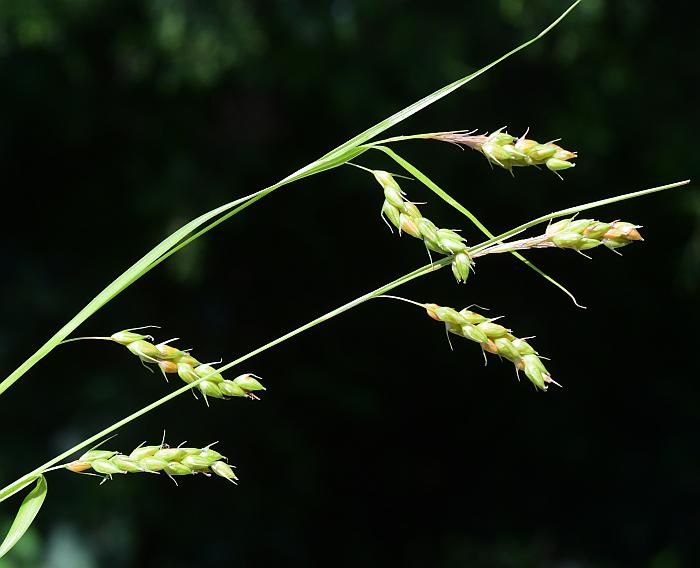Carex davisii Schwein. & Torr.

Native
CC = 3
CW = 0
MOC = 93
© SRTurner
Carex davisii Schwein. & Torr. | |
 |
Native CC = 3 CW = 0 MOC = 93 |
© SRTurner |
|
Family - Cyperaceae, Carex section Hymenochlaenae Habit - Monoecious sedge with short-creeping rhizomes, forming dense tufts or clumps, the sheaths of previous season's basal leaves sometimes persisting and becoming more or less dissected into hairlike fibers. Stems - Flowering stems 30-90 cm long, shorter than to longer than the leaves, sharply trigonous, glabrous or somewhat hairy on the angles, strongly purplish tinged at the base. Vegetative stems well developed, with several leaves, but shorter than the flowering stems. Leaves - Lowermost leaves reduced to nearly bladeless sheaths. Leaf blades 1-40 cm long, 3-8 mm wide, green to dark green, flat, glabrous or more commonly hairy, at least near the base of the undersurface. Leaf sheaths concave at the tip, glabrous to evenly hairy on both sides, the ligule about as long as wide or wider than long and U-shaped to broadly V-shaped, the ventral side thin and white, the lowermost sheath bases strongly purplish tinged.
Inflorescence - Terminal spike mostly staminate, but with few to several pistillate flowers toward the tip, the 2-3 lateral spikes pistillate. Terminal spikes 15-35 mm long, linear to narrowly oblanceolate in outline, the staminate scales 3.5-7.5 mm long, lanceolate, mostly awned at the tip, white with a green midrib. Pistillate spikes 20-40 mm long, 3-6 mm wide, short-to long-stalked, mostly erect when young, but usually nodding or drooping at maturity. Bracts well-developed, leaflike.
Perigynia - Pistillate scales 4.0-6.2 mm long, narrowly elliptic-ovate, tapered to a usually long awn, at least the uppermost pistillate scales with a definite awn more than half as long as the main body of the scale, white or pale green, with a green midrib. Perigynia 4.5-6.0 mm long, 2.0-2.5 mm wide, oblong-ovate in outline, broadest below the middle, circular to very bluntly trigonous in cross-section, tapered to a short beak with 2 minute, papery teeth at the tip, rounded to a stalklike base, the sides with several nerves, pale green to green, turning yellowish brown or dull orange at maturity. Fruits 2.2-2.6 mm long, yellowish brown, with deeply concave sides and blunt angles, the short beak straight or nearly so.
Flowering - May - July. Habitat - Bottomland and mesic forests, streambanks, roadsides, mesic pastures, disturbed, open, floodplain areas. Origin - Native to the U.S. Other info. - This sedge is found across Missouri. Missouri and Illinois are the states of its greatest abundance, but it also occurs in more scattered form throughout most of the upper Midwest and into New England and Canada. This species bears its lateral spikes on slender stalks, which tend to droop somewhat at maturity. The terminal spike has a large and conspicuous staminate region below the perigynia. The perigynia are nearly round in cross section, a bit like plump grains of wheat. The pistillate scales are distinctly awned, a feature which gives the spikes a distinctive appearance. The bases of the plants are typically reddish. Photographs taken at Little Lost Creek Conservation Area, Warren County, MO, 6-3-2018, Route 66 State Park, St. Louis County, MO, 5-20-2020, and along the Katy Trail near Dutzow, Warren County, MO, 6-7-2020 (SRTurner). |